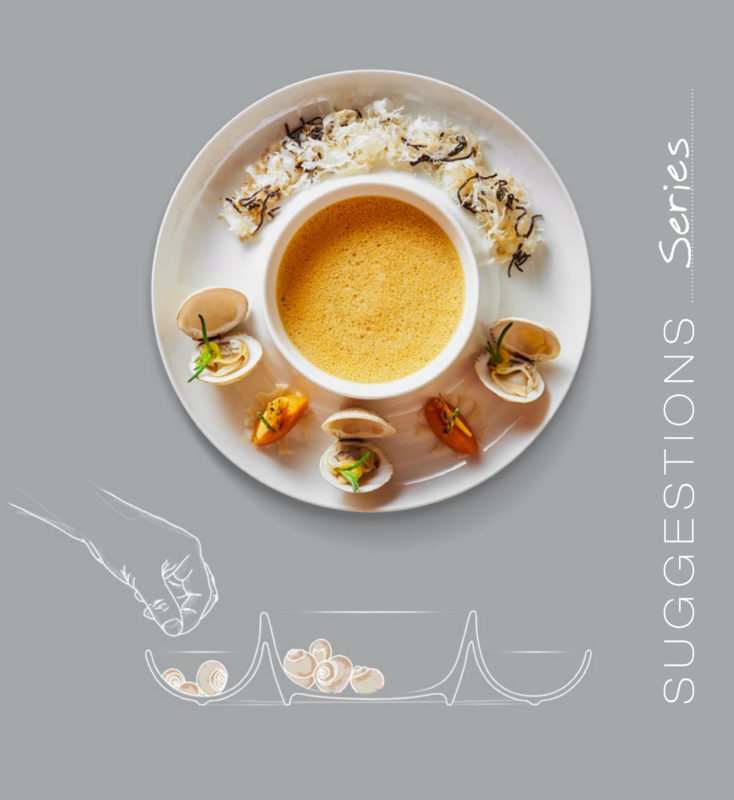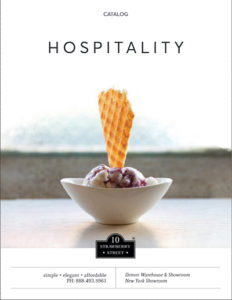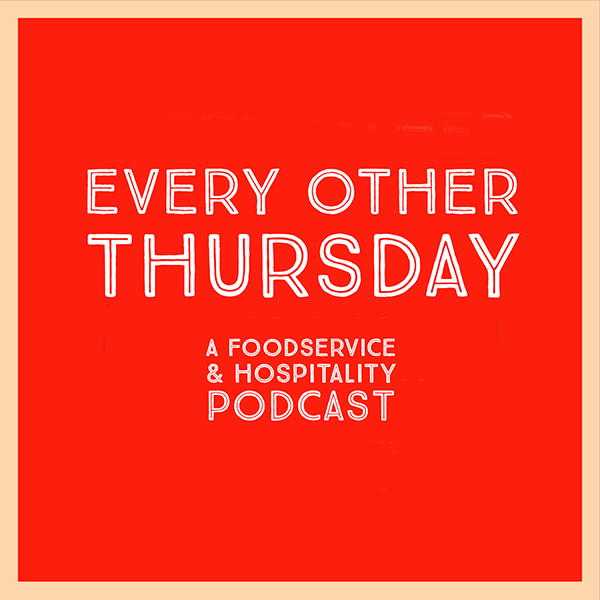Greg Kirrish Staring at a blank computer screen can be daunting. Imagine being asked to write “something meaningful, entertaining and engaging about foodservice dinnerware.” No matter how passionate and involved you are in the business, and I am, it’s tough to get a handle on the request. However, throughout 27 years working all over the world in the foodservice business, I have made some tabletop related observations and developed a couple corresponding growth recommendations that seem to reside somewhere outside the norm that I’d like to share.
I promise to be brief and try to provide some thought provoking ideas that may help you refine your plans, or at least possibly amuse you with their overreaching generalizations and quaint, homespun simplicity bordering on naiveté. Plus, you may be hearing more from me on this site in months (years?) to come. In any case, I’m definitely not your classic “tabletop” guy. So before delving into my pithy witticisms and anecdotes, I should introduce myself. If you’re still with me but want to skip the “up close and personal,” let’s reconnect after the next three paragraphs. See you there.
Fate has landed me in many facets of the foodservice world. My career started in the mid-1980’s conducting face-to-face, primary market research and developing strategic recommendations for major manufacturers and a wide array of operators. Along the way my focus became very tabletop-centric, with multiple assignments for clients like Corning and Villeroy & Boch. Projects focused on market sizing, competitor assessing, product developing, distribution analyzing and line rationalizing. In short, I did a lot of work trying to help dinnerware companies grow their businesses and squeeze out more profits. Similarly, I helped operators analyze all aspects of their brand, including the tabletop domain.
From consulting I jumped into marketing positions in Europe, Asia and in the US with Sara Lee, Kraft and other foodservice food and beverage suppliers. At this point you may be beginning to ask, “So what?” Well, even though Sara Lee, for example, was a coffee roaster, my “tabletop“ background helped me better understand the foodservice market, identify opportunities, and ultimately, grow the business. The same held true for my positions managing A.1., Grey Poupon and other products and brands. Ultimately, you can’t serve much coffee or steak sauce without cups and plates. Conversely, you can sell lots more beverages and condiments with the right tabletop accruements.
The next major phase of the foodservice whirlwind brought me to the National Restaurant Association where I helped develop and manage eight annual NRA Shows. Through several positions with the Association, the goal was always to connect operators with the services, information, contacts, services and products, including tabletop products, they need to improve their businesses. Most recently, I was responsible for the Show’s culinary demonstrations and education sessions, many of which were focused on tabletop, ambiance and decor issues. I’m now back where I began as a consultant focused on all aspects of the foodservice marketplace with my own firm, Kirrish & Associates, in green-leafy Kenilworth, Illinois.
Although it all may seem somewhat disjointed and removed from the tabletop, the experiences have provided unique “tabletop” perspectives, and hopefully lend some credibility. Now that you have a better understanding of my point-of-view, or skipped over it, let’s dive in, starting with the big takeaway that overrides every other observation:
1. Profitably managing a foodservice business is tough.
You already know foodservice is a tough battleground, but it’s worth repeating because it sets the tone for every related discussion. I have tremendous respect for anyone that can successfully run a foodservice operation. I can’t think of another job that requires so many smarts in so many different areas.
You know that operators need to wear marketing, accounting, human resources, nutritionist, sanitarian, interior designer and untold other hats to consistently serve up the “total dining experiences” that their increasingly fickle clientele demands. You should also know that dinnerware can make their lives better. More later about how dinnerware can help.
2. The more things change, the more they stay the same.
Looking back twenty-five-plus years, the issues plaguing restaurateurs and other foodservice operators were clear.
· Shortages of skilled, motivated, affordable labor
· Increasing rules & regulations with associated fees and requirements
· Constantly changing guest tastes and expectations
· A broad range of rising costs including those for mainstay food & beverages and equipment & supplies
· Healthcare
· Economic and political uncertainties clouding the horizon
Fast forward to 2012. Does this scenario sound familiar? Although today’s pace of change is arguably much greater and the stakes are much higher, operators are still dealing with most of the same basic challenges. See #3.
3. The list of challenges is not going to get smaller or easier.
The costs of gas and energy, water, and food commodities are high and expected to increase. Regulations and legislation are multiplying and tightening. Although the economy is showing glimmers of recovery, disposable income is still in short supply. As the list goes on, foodservice operators are coming under increasing pressures
4. Operators tend to jump on bandwagons.
Given all the challenges foodservice operators face, it’s no wonder that restaurants represent the highest failure rate of any U.S. business sector. It’s therefore also not surprising that operators tend to jump at fads, grasping to catch hold on any idea that could boost profits.
Were you around to remember when Chef Paul Prudhomme started the “Cajun” craze, blackening everything in sight, including Red Fish until they were driven to the edge of extinction. (No disrespect to the legendary Chef Paul intended.) How about the salad bar tidal wave? Quiche? Ferns? Perrier bottles as bud vases? Perhaps a little closer to home, big plates, small plates, decorated plates and then, just plain white plates? The list goes on and on with some fads becoming classic trends embedded in our culture, but most withering away and making room for the next in an unending cycle.
5. Guests are becoming increasingly sophisticated.
Food culture in general has obviously gone through a revolution. Who would have thought 25 or maybe even 10 years ago that chefs and restaurateurs could achieve rock star status? The media is serving up related news and entertainment 24/7 and the growing legions of foodies are devouring it. Along the way, everyone is now a “food expert” demanding “more and better” from their dining experiences.
These phenomena can be viewed by operators two ways, namely is the demitasse cup half full or half empty? Those that choose not to address the changes will probably not be around much longer. However, those that embrace the changes and properly address them have growth opportunities galore.
Let’s recap.
· It’s tough for operators to make a profit.
· It’s probably going to get tougher.
· Operators are stretched in many directions, trying to build their brands and deliver dining experiences.
If you thought that everything I’ve mentioned to this point is blatantly obvious, you’re probably not going to be surprised by my next revelation: The tabletop represents the essence of the operator’s brand and that’s where success, or failure, starts. However, it’s worth reminding ourselves about this basic tenant because the concept keeps getting taken for granted or lost in the jumble.
Regardless of your foodservice role or experience, it’s always good to take a moment to reflect and to become one with the all important tabletop. Close your eyes, take a deep breath, get zen-like and focus. Think of the tabletop as a palate from which you can project any mood or image you want.
Many operators miss untold opportunities because they fail to fully define their brand and think through how their tabletops can project and enhance it. Granted, it’s easier said than done, but that little piece of real estate holds untold power and opportunities. It’s the heart and soul of the place. Everyone involved should be focused on how it can be fully leveraged to reel customers in, engage , and ultimately satisfy them. Don’t just settle.
With that “settling” in mind, perhaps the pendulum has swung too far toward a “plain white” philosophy. Yes the food is the star, but there may be ways to make the food shine even brighter and the meal more enjoyable than against a minimalist backdrop. In any case, “plain white” has largely become the easy knee jerk decision. The operator feels comfortable with it and wants to make a decision and move on. The manufacturer and the dealer are darn glad to get the order and don’t want to make waves. The designer may want to pick other battles to fight. Plus, white goes with everything, right? Maybe or maybe not.
In all seriousness, I urge everyone to take a step back. What exactly are you trying to convey? Contemporary, Traditional, Ethnic, Hot, Cool, Casual, Elegant, Up, Down, North, South, East, West? The tabletop is where the rubber hits the road. It’s where guests are firmly ensconced and interacting. Everything – tablecloth, napkins, glassware, dinnerware, etc. etc. etc., – sends a message.
Maybe “plain white” might be perfect for a particular operation’s brand, but it should be a well thought out decision, and not just some flippant gesture. Maybe adding a galvanized metal pail to hold paper napkins and cutlery is the proper addition. Maybe decorated dinnerware coordinates well the rest of the décor. Maybe that Perrier bottle bud vase I mentioned earlier makes perfect sense. Maybe including something as novel as a “The Chork” (go ahead and google it) adds a fun addition. Maybe a special “tequila” glass makes the proper statement.
Successful examples can be found everywhere. My friend Bruno Loubet opened his aptly named Bistro Bruno Loubet in London’s trendy Zetter Hotellast year to incredible reviews. However, he took some heat from some quarters for serving bread in flowerpots. Fast forward to today and those whimsical flowerpots now represent his modern approach to traditional French bistro cuisine. I’m sure that his dinnerware provider would have preferred their products to those of a garden & lawn care purveyor, but the solution seems to have worked to everyone’s benefit. Last time I was there, the flowerpots were front and center.
The point is: If you’re a manufacturer, dealer or designer, take the time to look around, brainstorm and don’t be afraid to push the envelope. Also, don’t be afraid to allow other brands or products beyond yours to be included in the mix. Obviously, you can’t make or carry everything and in the end, you win with a satisfied, successful customer.
If you’re an operator, you especially need to be thoughtful and open. Yes it’s a scary world and the challenges I listed (and many more) are growing. However, the tough environment also presents opportunities. Everything you do, every decision you make, is brand defining. Everyone wins if they just put their heads together, starting with the tabletop. Stand tall and apart from the crowd. That doesn’t necessarily mean “go crazy.” Instead, I simply suggest that you take the chance to differentiate, differentiate, and differentiate some more, at the level that makes sense for your brand. If you take away just one thing from this encounter, it’s “brand differentiation starts with the tabletop.”
This topic is like peeling an onion, with layer upon layer of ideas and concepts to explore. Who would have thought that tabletops are the basis for life as we know it? I have more to say, but I’m ecstatic that you’ve kept up with me this far and hope this encounter is a springboard for further and deeper dialogue between us.
I welcome comments and ideas and look forward to the next time we meet.







